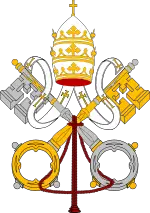Pope Silverius
| Silverius | |
|---|---|

| |
| Birth name | Silverius |
| Papacy began | June 8, 536 |
| Papacy ended | March 537 |
| Predecessor | Agapetus I |
| Successor | Vigilius |
| Born | ??? ??? |
| Died | June 20 537 Palmarola, Italy |
| Styles of Pope Silverius | |

| |
| Reference style | His Holiness |
| Spoken style | Your Holiness |
| Religious style | Holy Father |
| Posthumous style | Saint |
Pope Saint Silverius was pope from June 8, 536 to March 537).
He was a legitimate son of Pope Hormisdas, born before his father entered the priesthood. He was probably consecrated on June 8, 536.
He opposed the restoration of the monophysite heretic, former patriarch of Constantinople Anthimus, whom Agapetus had deposed, and thus brought upon himself the hatred of Empress Theodora. Theodora then sought to have Vigilius made pope. During Silverius' papacy, it was alleged that he had purchased his elevation to the see of St. Peter from King Theodahad.
On December 9 536, the Byzantine general Belisarius entered Rome, with the approval of Pope Silverius. Theodahad's successor, Witiges, gathered together an army and besieged Rome for several months, subjecting the city to privation and starvation. It was alleged that Pope Silverius wrote to Witiges offering to betray the city.
He was deposed accordingly by Belisarius in March 537 on a charge of treasonable correspondence with the Goths, and degraded to the rank of a simple monk. He found his way to Constantinople, and Justinian I, who entertained his complaint, sent him back to Rome, but Vigilius was eventually able to banish his rival to the prison island Pandataria (Ventotene), where the rest of his life was spent in obscurity. The date of his death is unknown.
According to the Liber Pontificalis, Pope St. Silverius was exiled not to Ventotene, but rather to Palmarola, where he died a couple of months later, on June 20 537.
Pope Silverius was later beatified and made into a saint and is now the patron saint of the island of Ponza, Italy.
He is also called Saint Silverius (San Silverio). According to Ponza Islands legend, fishermen were in a small boat in a storm off Palmarola and they called on Saint Silverius for help. An apparition of Saint Siverius called them to Palmarola where they survived. This miracle made him a saint.
According to the "New Catholic Encyclopedia" (1966), the dates of Pope Silverius' pontificate are in doubt: "June 1 or 8, 536, to c. Nov. 11, 537; d. Palmaria, probably Dec 2, 537." Likewise, he was never beatified or canonized, but simply acclaimed a saint by the people. The first mention of his name in a list of saints is in the 11th century.
ReferencesISBN links support NWE through referral fees
 "Pope St. Silverius" in the 1913 Catholic Encyclopedia.
"Pope St. Silverius" in the 1913 Catholic Encyclopedia.- Louise Ropes Loomis, The Book of Popes ("Liber Pontificalis"). Merchantville, NJ: Evolution Publishing. ISBN 1-889758-86-8 (Reprint of the 1916 edition. English translation with scholarly footnotes, and illustrations).
| Roman Catholic Popes | ||
|---|---|---|
| Preceded by: Agapetus I |
Bishop of Rome 536–537 |
Succeeded by: Vigilius |
| ||||||||||||||||
Incorporating text from the 9th edition (1887) of an unnamed encyclopedia.
Credits
New World Encyclopedia writers and editors rewrote and completed the Wikipedia article in accordance with New World Encyclopedia standards. This article abides by terms of the Creative Commons CC-by-sa 3.0 License (CC-by-sa), which may be used and disseminated with proper attribution. Credit is due under the terms of this license that can reference both the New World Encyclopedia contributors and the selfless volunteer contributors of the Wikimedia Foundation. To cite this article click here for a list of acceptable citing formats.The history of earlier contributions by wikipedians is accessible to researchers here:
The history of this article since it was imported to New World Encyclopedia:
Note: Some restrictions may apply to use of individual images which are separately licensed.